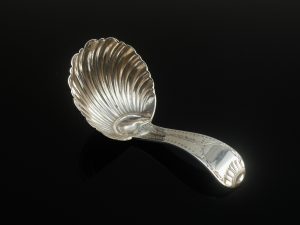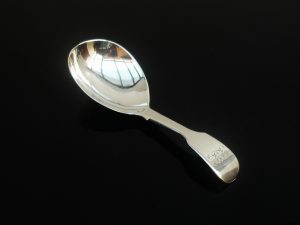Description
Silver Table Serving Spoon
Scottish provincial silver table serving spoon by Peter Lambert c.1820, either Dundee or Aberdeen marks.
Engraved initials to terminal.
In excellent order with a good point to bowls tip and well preserved marks.
Measures 212mm in length.
| DATE | c.1820 |
| MAKER or SPONSOR MARK | Peter Lambert |
| ASSAY OFFICE | Dundee or Aberdeen |
| WEIGHT (Grammes) | 60 |
| WEIGHT (Troy) | 1.92 |
| REF:- | 287K |
Before Mass Production
In the days before mass production items made from metal were regarded as treasures. Eating utensils were often made from wood and metal was reserved for more robust uses. However, in the colonial period a silver spoon became an incredibly practical item to own and had a multitude of uses.
Spoons are among the oldest eating utensils although there are many different types of spoon throughout the world. Spoons preceded knives and forks and were the main utensil at mealtimes.
In the 17th century, people who could afford them, had their own spoons and would bring them to a meal wherever that was being eaten. Furthermore, the influx of wealth from the colonies led to the expansion of the middle classes and they began to realise that they too could own silver spoons.
Silver spoons were helpful in avoiding poisons as they would tarnish on contact with sulphur, arsenic, and other dangerous compounds. This was very useful in a time when testing for poison wasn’t always possible and food hygiene was unheard of.
Silver spoons were often included in a bride’s dowry and also became gifts that marked huge life events like birth or marriage. The tradition of a sterling silver baby spoon continued well into the 20th century.
It wasn’t until the 19th century that entire sets of silverware in sterling silver became the status symbols they can now be regarded as and serving spoons were a vital part of the set.
















